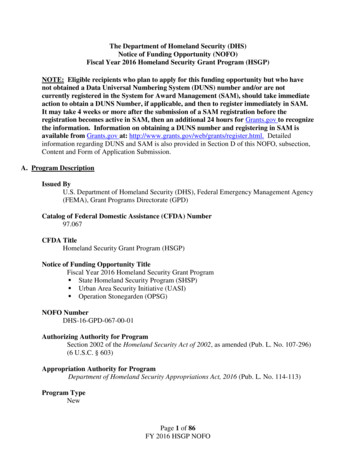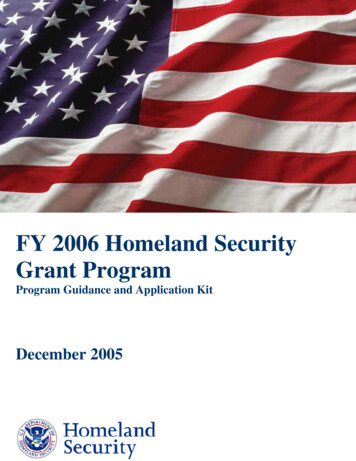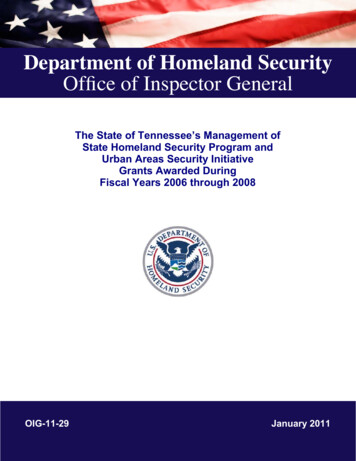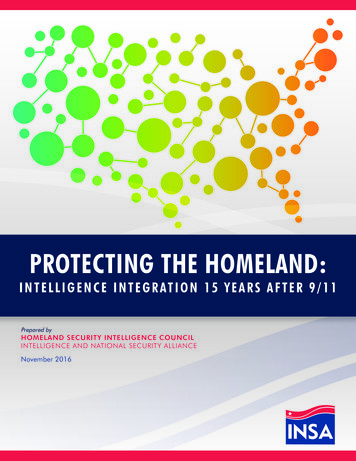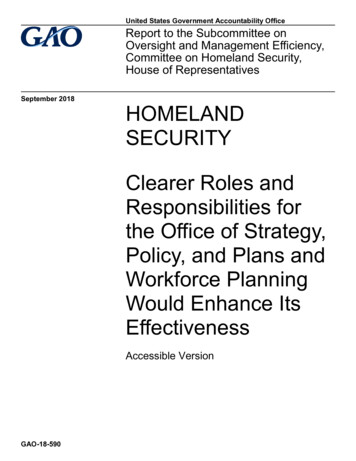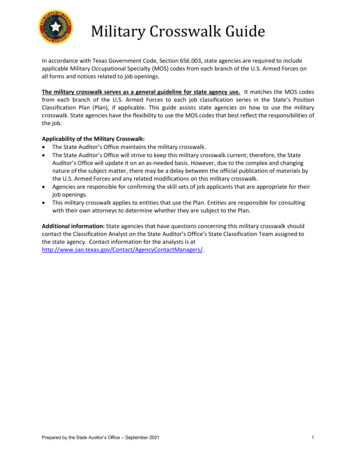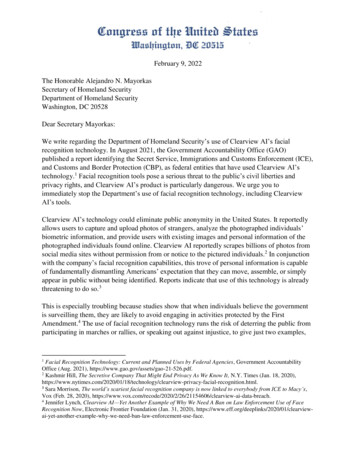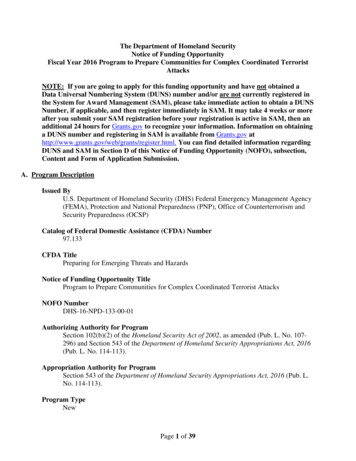
Transcription
The Department of Homeland SecurityNotice of Funding OpportunityFiscal Year 2016 Program to Prepare Communities for Complex Coordinated TerroristAttacksNOTE: If you are going to apply for this funding opportunity and have not obtained aData Universal Numbering System (DUNS) number and/or are not currently registered inthe System for Award Management (SAM), please take immediate action to obtain a DUNSNumber, if applicable, and then register immediately in SAM. It may take 4 weeks or moreafter you submit your SAM registration before your registration is active in SAM, then anadditional 24 hours for Grants.gov to recognize your information. Information on obtaininga DUNS number and registering in SAM is available from Grants.gov athttp://www.grants.gov/web/grants/register.html. You can find detailed information regardingDUNS and SAM in Section D of this Notice of Funding Opportunity (NOFO), subsection,Content and Form of Application Submission.A. Program DescriptionIssued ByU.S. Department of Homeland Security (DHS) Federal Emergency Management Agency(FEMA), Protection and National Preparedness (PNP), Office of Counterterrorism andSecurity Preparedness (OCSP)Catalog of Federal Domestic Assistance (CFDA) Number97.133CFDA TitlePreparing for Emerging Threats and HazardsNotice of Funding Opportunity TitleProgram to Prepare Communities for Complex Coordinated Terrorist AttacksNOFO NumberDHS-16-NPD-133-00-01Authorizing Authority for ProgramSection 102(b)(2) of the Homeland Security Act of 2002, as amended (Pub. L. No. 107296) and Section 543 of the Department of Homeland Security Appropriations Act, 2016(Pub. L. No. 114-113).Appropriation Authority for ProgramSection 543 of the Department of Homeland Security Appropriations Act, 2016 (Pub. L.No. 114-113).Program TypeNewPage 1 of 39
Program Overview, Objectives, and PrioritiesOverviewPreparedness is the shared responsibility of our entire Nation. Each communitycontributes to achieving the National Preparedness Goal by assessing and preparing forthe risks that are most relevant and urgent for them individually, which in turnstrengthens our collective security and resilience as a Nation. As new threats and hazardsemerge, communities need to assess their risk and take the necessary steps to prepare.From 2008 to present, recent terrorist incidents, such as those in Boston, Massachusetts;Nairobi, Kenya; San Bernardino, California; Paris, France; and Brussels, Belgium,highlight the emergence of a more recent threat known as complex coordinated terroristattacks. Complex coordinated terrorist attacks are acts of terrorism that: involvesynchronized and independent team(s) at multiple locations sequentially or in closesuccession, initiated with little or no warning, and employing one or more weaponsystems: firearms, explosives, fire as a weapon, and other non-traditional attackmethodologies which are intended to result in large numbers of casualties. These attacksrepresent an evolving and dynamic terrorist threat, shifting from symbolic, highlyplanned and structured Al Qaeda-style attacks (terrorist-directed) focused on highvisibility targets to threats that are more diffuse, difficult to detect, and less costly toimplement (terrorist-inspired). The emergence of these types of threats represent a needfor communities to work towards strengthening their capabilities in order to prepare for,prevent, and respond to a complex coordinated terrorist attack.The Fiscal Year (FY) 2016 Program to Prepare Communities for Complex CoordinatedTerrorist Attacks (CCTA Program) provides funding to local, state, tribal, and territorialjurisdictions of different types, sizes, and capabilities to improve their ability to preparefor, prevent, and respond to complex coordinated terrorist attacks in collaboration withthe whole community. The whole community approach should aim to include individualsand communities, the private and nonprofit sectors, faith-based organizations, and alllevels of government (local, regional/metropolitan, state, tribal, territorial, insular area,and Federal). The FY 2016 CCTA Program also focuses on developing regionalpartnerships intended to strengthen the applicant’s capacity for building and sustainingcapabilities specific to identifying gaps, planning, training, and exercising associated withpreparing for, preventing, and responding to a complex coordinated terrorist attack.Program ObjectiveThe FY 2016 CCTA Program objective is to build and sustain capabilities of local, state,tribal, and territorial jurisdictions to enhance their preparedness for complex coordinatedterrorist attacks by achieving the following activities: Identifying capability gaps related to preparing for, preventing, and responding to acomplex coordinated terrorist attack. Developing and/or updating plans, annexes, and processes to address the identifiedgaps. Training personnel and the whole community to implement the plans and processesand build needed capabilities. Conducting exercise(s) to validate capabilities and identify opportunities foradditional corrective action.Page 2 of 39
Program PrioritiesThe FY 2016 CCTA Program will prioritize projects that incorporate the followingfactors: Develop comprehensive and sustainable approaches to enhance preparedness forcomplex coordinated terrorist attacks. Develop and advance regional partnerships and whole community collaboration. Promote creative, innovative, and replicable approaches to preparing for complexcoordinated terrorist attacks. Develop and share lessons learned and best practices associated with preparing forcomplex coordinated terrorist attacks between jurisdictions.B. Federal Award InformationAward Amounts, Important Dates, and ExtensionsAvailable Funding for the NOFO: 35,940,000Maximum Funding per Applicant: 2,500,000Awarded funds under the FY 2016 CCTA Program are competitive-based. Applicantsapplying for grant funds are eligible to apply for up to, but no more than, 2,500,000.Projected number of Awards:25 – 30Period of Performance:Thirty-six (36) monthsFEMA will not grant extensions to the period of performance.Projected Period of Performance Start Date(s):06/08/2017Projected Period of Performance End Date(s):06/07/2020Funding InstrumentGrantC. Eligibility InformationEligible Applicants Local governments (as defined by 2 C.F.R. § 200.64) State governments (includes all 56 states and territories, which includes any state ofthe United States, the District of Columbia, the Commonwealth of Puerto Rico, theVirgin Islands, Guam, American Samoa, and the Commonwealth of the NorthernMariana Islands) Federally-recognized Tribal governmentsPage 3 of 39
Eligibility Criteria1. Eligible applicants may submit only one application. Applicants may choose and areencouraged to partner with multiple jurisdictions. Applications must include: Names of all jurisdiction(s) partnering on the project.A letter of support from the primary applicant’s appropriate senior executive official(e.g., Governor, Mayor, County Executive, City Manager) that supports the projectand participation of additional jurisdictions for completing the full program andproviding the necessary resources.If applicable, information on the relationship between the applicant and partneringjurisdictions, e.g. existing letters of cooperation/support or administrative agreements,such as Memoranda of Understanding (MOU).2. Applications must conform to the guidance provided in Appendix A – Project NarrativeTemplate of this NOFO. Applicants that do not meet eligibility and application submissionrequirements will not be evaluated and scored by the review panel.Other Eligibility CriteriaNational Incident Management System (NIMS) ImplementationPrior to allocation of any FY 2016 Federal preparedness awards, recipients must ensureand maintain adoption and implementation of NIMS. Emergency management andincident response activities require carefully managed resources (personnel, teams,facilities, equipment, and/or supplies) to meet incident needs. Use of the standardizedresource management concepts such as typing, credentialing, and inventorying promotesa strong national mutual aid capability needed to support delivery of core capabilities.Additional information on resource management and NIMS resource typing definitionsand job titles/position qualifications is available on DHS/FEMA’s website l-aid.DHS/FEMA developed the NIMS Guideline for Credentialing of Personnel to describenational credentialing standards and provide written guidance regarding the use of thosestandards. That guideline describes credentialing and typing processes and identifies toolsthat Federal Emergency Response Officials (FEROs) and emergency managers at alllevels of government may use, both routinely and to facilitate multijurisdictionalcoordinated responses.Although local, state, tribal, territorial, and private sector partners—includingnongovernmental organizations—are not required to credential their personnel inaccordance with NIMS guidelines, DHS/FEMA strongly encourages them to do so inorder to leverage the Federal investment in the Federal Information Processing Standards(FIPS) 201 infrastructure and to facilitate interoperability for personnel deployed outsidetheir home jurisdiction. Additional information is available at -tools.Page 4 of 39
Maintenance of Effort (MOE)Maintenance of effort is NOT required under this program.Cost Share or MatchCost share or match is NOT required under this program.D. Application and Submission InformationDHS/FEMA will only accept one application from each applicant. Any applicant who submits twoor more applications for this program may be disqualified.Key Dates and TimesDate Posted to Grants.gov:December 7, 2016Application Submission Deadline:February 10, 2017 at 11:59:59 PM ETApplicants are required to submit their applications to DHS/FEMA by the establisheddeadline. The Non-Disaster (ND) Grants System has a date stamp that indicates when anapplication is submitted. Applicants will receive an electronic message confirmingreceipt of the full application. In general, DHS/FEMA will not review applicationssubmitted after the deadline or consider them for funding. DHS/FEMA may, however,extend the application deadline on request for any applicant who can demonstrate goodcause exists to justify extending the deadline. Good cause for an extension may includetechnical problems outside of the applicant’s control that prevent submission of theapplication by the deadline, or other exigent or emergency circumstances. If applicantsexperience technical issues, they must notify the FEMA Help Desk as soon as possible.Anticipated Funding Selection Date:April 10, 2017Anticipated Award Date:No Later Than September 30, 2017Other Key DatesEventObtaining a Data Universal NumberSystem (DUNS) NumberObtaining a valid EmployerIdentification Number (EIN)Updating System for AwardManagement (SAM registrationBecoming an AuthorizedOrganizational Representative (AOR)Starting application in Grants.govSubmitting complete application inNon-Disaster GrantsSuggested Deadline For CompletionFour weeks before actual submission deadlineFour weeks before actual submission deadlineFour weeks before actual submission deadlineFour weeks before actual submission deadlineOne week before actual submission deadlineOne week before actual submission deadlinePage 5 of 39
Address to Request Application PackageApplication forms and instructions are available at Grants.gov. To access these materials,go to http://www.grants.gov, select “Applicants,” then “Apply for Grants.” In order toobtain the application package select “Download a Grant Application Package.” Enter theCFDA and/or the funding opportunity number located on the cover of this NOFO, select“Download Package,” and then follow the prompts to download the application package.In addition, the Telephone Device for the Deaf (TDD) and/or Federal Information RelayService (FIRS) number available for this Notice is (800) 462-7585.DHS/FEMA will process initial applications through the Grants.gov portal and thecomplete application through the ND Grants System.Content and Form of Application SubmissionApplying for an award under this program is a multi-step process and requires time tocomplete. To ensure that DHS/FEMA will consider your application for funding,applicants should start the prerequisite steps required to submit an application wellin advance of the submission deadline, leaving enough time to submit an applicationby the deadline in the event a technical or other issue arises. The registrationprocess can take four weeks or longer to complete. Please review the table aboveunder “Submission Dates and Other Key Dates and Times” for estimated deadlinesto complete each of the prerequisite steps listed below. Failure of an applicant tocomply with any of the required steps before the application deadline may disqualifytheir application from funding.Unique Entity Identified and System for Award Management (SAM)The following prerequisite steps are required to apply for an award under this program:1. Applying for, updating, or verifying their DUNS Number2. Applying for, updating, or verifying their EIN Number3. Updating or verifying their SAM Number4. Create a user name and password with grants.Gov to become an AOR5. Submitting an initial application in Grants.gov, and6. Submitting the complete application in Non-Disaster Grants.DHS/FEMA will only accept electronic applications. It will not accept hard copyapplications.1. Data Universal Number System (DUNS) number. Instructions for obtaining aDUNS number are available at the following ber.html. The DUNS number must be included in the data entry fieldlabeled "Organizational DUNS" on the Standard Forms (SF)-424 forms submitted aspart of this application.2. Employer Identification Number (EIN)DHS/FEMA requires both the EIN and a DUNS number prior to the issuance of afinancial assistance award and for grant award payment; both EIN and DUNS are alsorequired to register with SAM (see below). The EIN base for an organization is thePage 6 of 39
Internal Revenue Service (IRS) Tax ID number, and for individuals it is their socialsecurity number, (both the EIN and social security number are nine-digit numbers).Organizations and individuals submitting their applications must correctlydifferentiate the EIN from the DUNS, as both are nine-digit numbers. Pleasedifferentiate your EIN number from your DUNS number or this may result in a delayin the issuance of the funding award or incorrect payment to a recipient organization.Organizations applying for an EIN should plan on a minimum of two full weeks toobtain an EIN. For assistance in registering an EIN, please contact the IRS helpline.DHS/FEMA cannot assist applicants with questions related to obtaining a currentEIN.3. System for Award Management (SAM)Step-by-step instructions for registering with SAM can be found . Failure to register with SAM will result in the rejection ofyour application by Grants.gov during the submissions process.4. Authorized Organizational Representative (AOR). The next step in the registrationprocess is to create a username and password with Grants.gov to become an AOR.AORs will need to know the DUNS number of the organization for which they willbe submitting applications to complete this process. Applicants must register theindividual who is able to make legally binding commitments for the applicantorganization as the AOR. Applicants often miss this step; however, it is crucial forvalid submissions. To read more detailed instructions for creating a profile onGrants.gov visit OR Authorization. After creating a profile on Grants.gov, the E-Biz Point ofContact (POC), who is a representative from your organization listed as the contactfor SAM, will receive an email to grant the AOR permission to submit applicationson behalf of their organization. The E-Biz POC will then log in to Grants.gov andapprove an individual as the AOR, thereby giving him or her permission to submitapplications. After receiving his or her approval, the AOR will be able to submit anapplication online. To learn more about AOR Authorization, tml. To track AOR status, ml.Electronic Signature. Applications submitted through Grants.gov constitute asubmission as electronically signed applications. When you submit the applicationthrough Grants.gov, the name of your AOR on file will be inserted into the signatureline of the application.If you experience difficulties accessing information or have any questions, please callthe grants.gov customer support hotline at (800) 518-4726 or email Grants.gov atsupport@grants.gov.Page 7 of 39
The Federal awarding agency will not grant a Federal award to an applicant until theapplicant has complied with all applicable DUNS and SAM requirements. If anapplicant has not fully complied with the requirements by the time the Federalawarding agency is ready to make a Federal award, the Federal awarding agency maydetermine that the applicant is not qualified to receive a Federal award and use thatdetermination as a basis for making a Federal award to another applicant.5. Submitting an Initial Application in Grants.govAll applicants must submit their initial application through Grants.gov. If do you notalready have a user profile on grants.gov, you will need to create one by visiting theGet Registered section of the Grants.gov website. Successful completion of this stepis necessary for DHS/FEMA to determine eligibility of the applicant. Applicantsshould complete this initial step on-line, which requires completing: Standard Form 424 (SF-424), Application for Federal Assistance.The form is available in the Forms tab under SF-424 Family. The initial applicationcannot be started or submitted in Grants.gov unless the applicant’s registration inSAM is confirmed.ND Grants will retrieve the information submitted in Grants.gov, which will allowDHS/FEMA to determine if an applicant is eligible.Applicants experiencing difficulties accessing information should call the Grants.govcustomer support hotline at 800-518-4726 or email Grants.gov atsupport@grants.gov. DHS/FEMA cannot assist applicants with questions related toregistering with Grants.gov.6. Submitting the Complete Application in the ND Grants SystemDHS/FEMA will notify eligible applicants after the initial application is submitted inGrants.gov and asked to proceed with submitting their complete application packagein ND Grants. Applicants can register early with ND Grants and are encouraged tobegin their ND Grants registration at the time of this announcement. Earlyregistration will allow applicants to have adequate time to start and complete theirapplication.ND Grants will prompt applicants to submit all of the information contained in thefollowing forms. Applicants should review these forms before applying to ensure theyinclude all required information. Forms are located andatory-family.html#sortby 1. Standard Form 424A, Budget Information (Non-construction)Standard Form 424B, Standard Assurances (Non-construction)Standard Form LLL, Disclosure of Lobbying ActivitiesIndirect Cost Rate Agreement, if applicablePage 8 of 39
In addition, applicants must submit copies of the following in ND Grants: Project Narrative that describes the applicant’s proposed project and how italigns with the FY 2016 CCTA Program Objectives. (Refer to Appendix A –Project Narrative Template for additional details.) Budget Detail Worksheet that identifies all project costs and providesjustification for the costs identified (including management and administration[M&A]). (Refer to Appendix B – Budget Detail Worksheet and Template foradditional details.) Letter of Support from the primary applicant’s appropriate senior executiveofficial (e.g., Governor, Mayor, County Executive, City Manager) that supportsthe project and participation of additional jurisdictions for completing the fullprogram and providing the necessary resources.Applicants needing assistance registering for the ND Grants system should contactndgrants@fema.gov or (800) 865-4076.Intergovernmental ReviewAn intergovernmental review may be required. Applicants must contact their State’sSingle Point of Contact (SPOC) to comply with the State’s process under ExecutiveOrder 12372 (see http://www.fws.gov/policy/library/rgeo12372.pdf). Name and addressesof the SPOCs are maintained at the Office of Management and Budget’s home page athttp://www.whitehouse.gov/omb/grants spoc to ensure currency.Funding RestrictionsFederal funds made available through this award may only be used for the purpose setforth in this award and must be consistent with the statutory authority for the award.Award funds may not be used for matching funds for any other Federal award, lobbying,or intervention in Federal regulatory or adjudicatory proceedings. In addition, Federalfunds may not be used to sue the Federal Government or any other government entity.Management and Administration (M&A) CostsM&A activities are those directly relating to the management and administration of theFY 2016 CCTA Program funds, such as financial management and monitoring.Recipients may retain up to a maximum of five percent (5%) of the FY 2016 CCTAProgram funds awarded solely for M&A purposes associated with the FY 2016 CCTAProgram award. Recipients may not retain funds for any purpose other than to coverM&A costs. Sub-recipients may also retain up to a maximum of five percent (5%) offunding passed through by the recipient solely for M&A purposes associated with the FY2016 CCTA Program award.Indirect (Facilities & Administrative (F&A)) CostsIndirect costs are allowable under this program as described in 2 C.F.R. § 200.414. Withthe exception of those recipients who have never received a negotiated indirect cost rateas described in 2 C.F.R. § 200.414(f), recipients must have an approved indirect cost rateagreement with their cognizant Federal agency to charge indirect costs to this award. Acopy of the approved rate (a fully executed, agreement negotiated with the applicant’scognizant Federal agency) is required at the time of application, and must be provided toDHS/FEMA before indirect costs are charged to the award.Page 9 of 39
Pre-award CostsPre-award costs are allowable only with the prior written approval of DHS/FEMA and ifthey are included in the award agreement. To request pre-award costs, an applicant mustinclude a written request signed by the Authorized Representative of the entity in his orher application. The letter must outline the purpose of the pre-award costs, including adetailed budget breakout distinguishing pre-award costs from the post-award costs and ajustification for approval.Direct CostsCost PrinciplesCosts charged to this award must be consistent with the Cost Principles for FederalAwards located at 2 C.F.R. Part 200, Subpart E.PersonnelPersonnel hiring, overtime, and backfill expenses, including related fringe benefits, arepermitted under this program in order to perform allowable identifying gaps, planning,training, and exercise activities. Overtime costs for backfill and overtime to allowpersonnel to train or participate in exercises are allowed under this program only asdescribed in this NOFO. Personnel costs for routine patrols or interdiction operations arenot an allowable cost under this program.Consultants/ContractorsHiring of full-time or part-time contract planners or consultants to assist with identifyinggaps, planning, training, and exercise activities is allowable under this program. Hiringpublic safety personnel fulfilling traditional public safety duties is not an allowable costunder this program.TravelDomestic travel costs are allowed under this program, as provided for in this NOFO.International travel is not an allowable cost under this program unless approved inadvance by DHS/FEMA.EquipmentOperational equipment, such as incident command vehicles, are not an allowable costunder this program. Some equipment costs are eligible but are specifically limited totesting and exercising response and preparedness plans safely and comprehensively (e.g.,safety equipment, simunitions). This excludes equipment used for fulfilling traditionalpublic safety duties.Such equipment costs are only allowable under this program with the prior writtenapproval of DHS/FEMA. To request equipment, the Authorized Representativemust sign a written request that outlines the equipment costs.ConferencesRental of space/locations for conferences, meetings, workshops, and webinars areallowable under this program to perform gap identification, planning, training, andPage 10 of 39
exercise activities. Recipients are encouraged to use free public space/locations,whenever available, prior to the rental of space/locations.SuppliesMaterials or supplies are allowable under this program to conduct gap identification,planning, training, and exercise activities.Construction and RenovationConstruction and renovation costs are not an allowable cost under this program.E. Application Review InformationApplication Evaluation CriteriaPrior to making a Federal award, the Federal awarding agency is required by 31 U.S.C.3321 and 41 U.S.C. 2313 to review information available through any Office ofManagement and Budget (OMB)-designated repositories of government wide eligibilityqualification or financial integrity information. Therefore, application evaluation criteriamay include the following risk-based considerations of the applicant: (1) financialstability; (2) quality of management systems and ability to meet management standards;(3) history of performance in managing Federal awards; (4) reports and findings fromaudits; and (5) ability to implement effectively statutory, regulatory, or otherrequirements.Applications must conform with the guidance provided in Appendix A – ProjectNarrative Template of this NOFO. Applicants that do not meet eligibility and applicationsubmission requirements will not be evaluated and scored by the review panel.FEMA will evaluate applications based on the following criteria (see Appendix D –Evaluation and Scoring Criteria for additional details): Need: The applicant’s demonstration of need for grant funds, including identificationof their capability gaps related to complex coordinated terrorist attacks and anexplanation of resource limitations to address the identified gaps.(Possible Points: 0 – 20 max) Design and Implementation: The applicant’s demonstration of an effective andsustainable project approach for achieving the FY 2016 CCTA Program objectiveswithin the 36-month period of performance, including the specific projectimplementation, project management, and regional and whole communityapproaches. Applicant’s will also be evaluated based on their use of creative andinnovative project approaches and plan to share project results with other jurisdictionsto amplify the impact of their project.(Possible Points: 0 – 52 max) Impact: The applicant’s demonstration of the proposed project’s impact, includinghow the project will increase the jurisdiction’s preparedness and resilience forcomplex coordinated terrorist attacks and how collaboration with identified regionalPage 11 of 39
partners and whole community stakeholders will enhance project effectiveness.(Possible Points: 0 – 16 max) Budget: The applicant’s demonstration of a reasonable and cost-effective budget(based on the Budget Detail Worksheet and Project Narrative), including explanationof reasonable project costs across the requested categories and the project’s relativecost effectiveness.(Possible Points: 0 – 12 max)FEMA will not consider any letters of endorsement or support, submitted separately froman application. If statements of endorsement or support testimony are provided, they mustbe included in the Project Narrative.Review and Selection ProcessReview ProcessThe FY 2016 CCTA Program applications will receive an initial screening to verifyapplicant eligibility, prior to the application panel’s review. Eligibility Screening. FEMA will conduct an initial review of all applications toverify applicant eligibility and ensure each application is complete. All eligible andcomplete applications will progress to the applicable program office for furtherreview. FEMA staff will review the following during the eligibility screening:- Applicant is an eligible jurisdiction.- Applicant has submitted only one application.- Applicant has submitted a letter of support.- Applicant has submitted all required assurances and standard forms.- Application includes a Project Narrative that aligns with the formatrequirements specified in Appendix A – Project Narrative Template.- Application includes a Budget Detail Worksheet.FEMA will not process incomplete applications for further review and will notconsider them for funding. Review Panel. Applications will be reviewed and scored by a review panelcomprising personnel from FEMA, select other Federal Agencies, and external (nonFederal) subject matter experts (as necessary) representing organizations that haveexperience and/or advanced training in complex coordinated terrorist attacks. Thereview panel will score applications based on the aforementioned evaluation criteria,taking into consideration completeness, adherence to programmatic guidelines, andantici
Homeland Security Act of 2002, as amended (Pub. L. No. 107-296) and Section 543 of the Department of Homeland Security Appropriations Act, 2016 (Pub. L. No. 114-113). Appropriation Authority for Program Section 543 of the Department of Homeland Security Appropriations Act, 2016 (Pub. L. No. 114-113). Program Type New . Page 1 of 39



